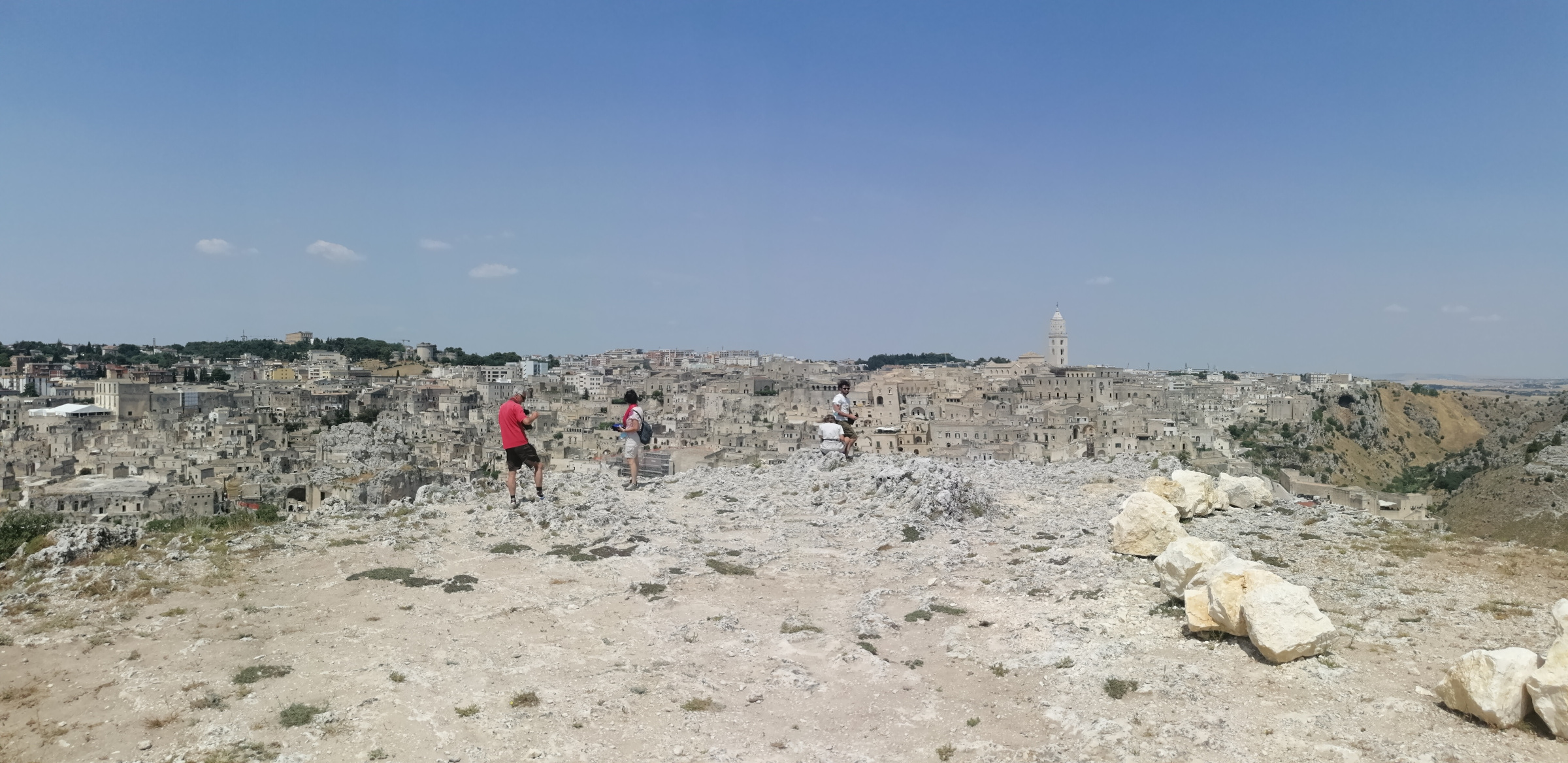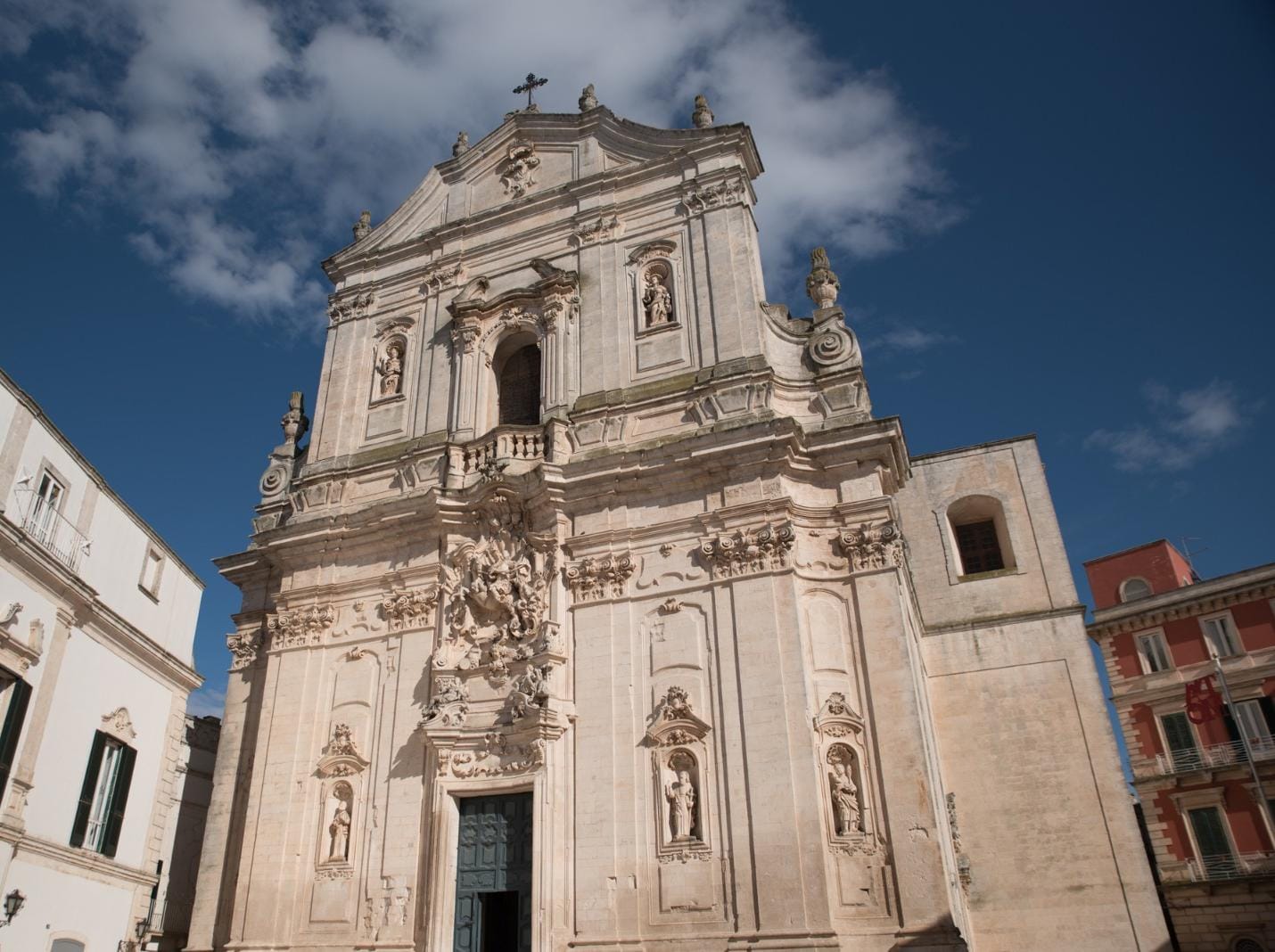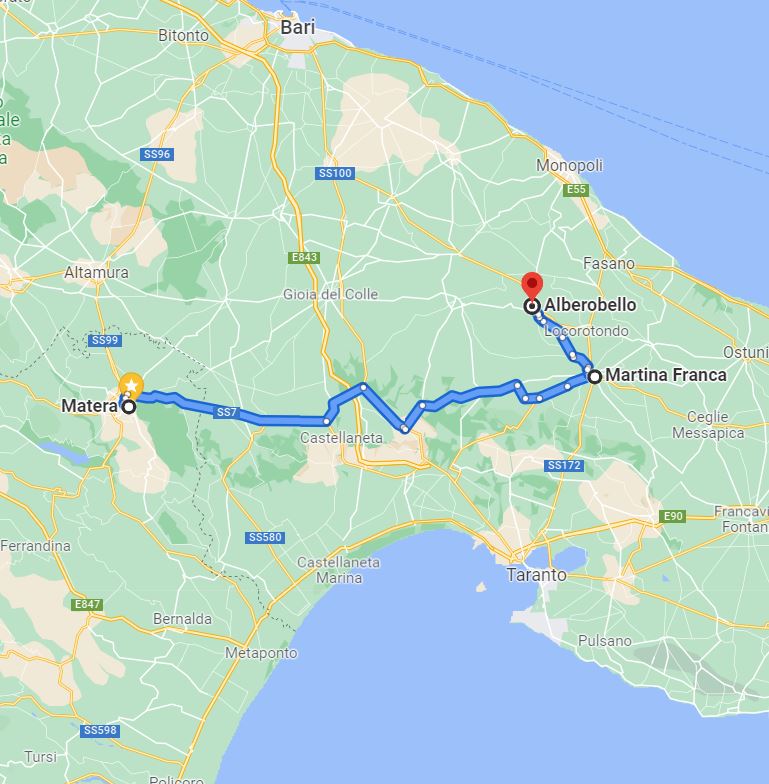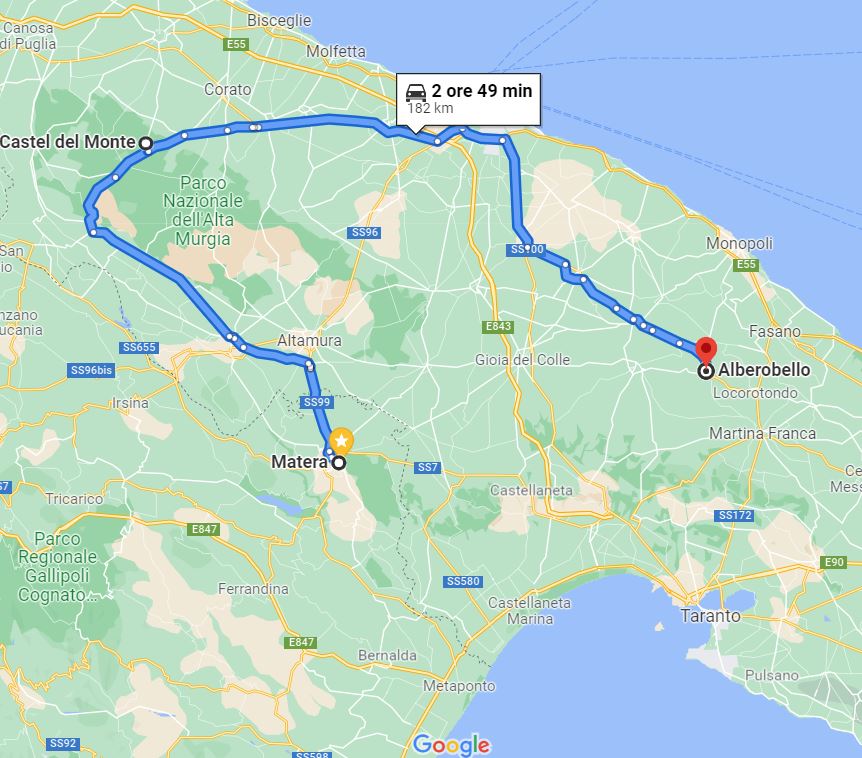RENTAL SERVICES WITH DRIVER
FROM AND TO MATERA
RATES
Matera | Alberobello shared service
Shuttle Matera
by Made in South of Italy
Matera | Alberobello shared service
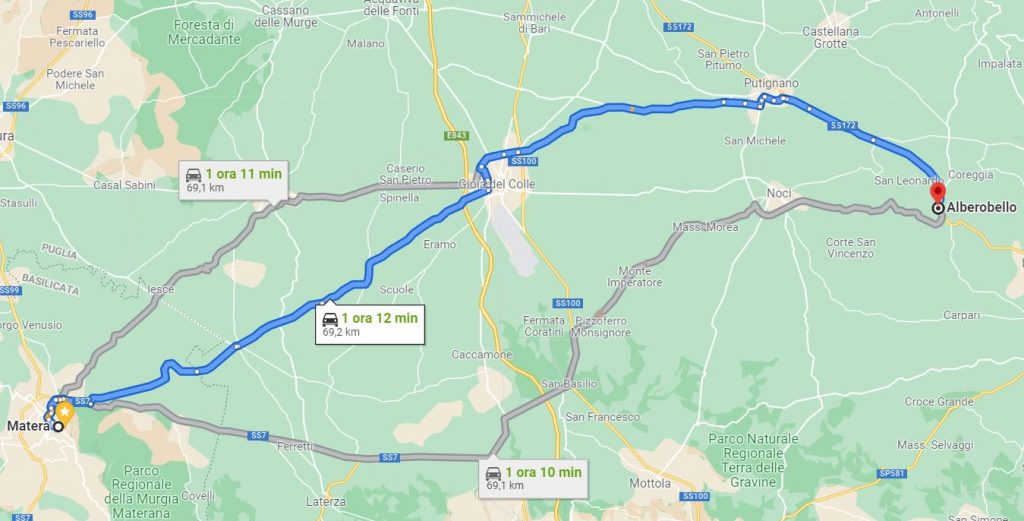
| number of passengers | fare * without sharing** |
| 1 pas. | € 85.00 |
| 2 pass. | € 90.00 |
| 3 pass. | € 100.00 |
| 4 pass. | € 110.00 |
| 5 pass. | € 130.00 |
| 6 pass. | € 130.00 |
| 7 pass. | € 140.00 |
| 8 pass. | € 140.00 |
| ** discount with sharing | |
| within 30 minutes | -10 |
| over 30 minutesi | -20 |
* total fare for number of passengers, excluding VAT 10%
PLEASE NOTE!
The above rates are valid for companies directly affiliated with us and confirmed at the time of booking. If our machines from the partner companies are not available, other solutions will be proposed and agreed and, in this case, the rates may vary
time slot
from 7:00 (car departure time from Matera)
to 21:00 (arrival time car in Matera)
from 21:00 to 7:00 check additional charges
additional charges
working days outside the time slot + € 10,00
Sunday surcharge +€ 10,00
festive surcharge +30%
driver available for the first 3 hours + € 30,00/h
driver at disposal from the fourth hour + € 25,00/h
Our fares include
car rental with driver;
passenger insurance;
fuel cost;
driver waiting in case of flight or train delay.
Our fares do not include
TAX 10%;
Motorway tolls, car parks or ferry tickets;
Meals and overnight stays for full day driver;
everything not expressly indicated in "the rates include"
Please note!
in all cases where it is impossible to reach the desired places or carry out transfers for problems not arising from our will (such as road surface inaccessibility, snow, dangerous situations, etc.) We reserves the right to NOT MAKE the transfer in the times and places previously booked and to agree on the cancellation or variation of the transfer arrangements, as well as the rates on the days and times of departure or meeting.
Possibili escursioni in aggiunta al servizio
da Matera a Alberobello o viceversa
Belvedere (Murgia Timone)
>Murgia Timone, together with Murgecchia, is a plateau located in front of the heart of the Sassi and the oldest part called "La Civita" just past the river Gravina. The whole surrounding area is characterized by the presence of caves well visible from the ancient tufa districts. In this area was discovered the first entrenched village. The discovery is attributed to the peasant materano Giovanni Iacovuzzi, one of the most valuable collaborators of Ridola.
The neolithic village
The village has an almost oval shape and gathers more Neolithic huts. In the outer part of this village there is a moat, defined by Ridola a "Trench", excavated most likely with stone tools. This moat has a width between 1.90 and 2.70 meters in width and a depth between 1.50 and 2.50 meters for a total perimeter of the moat is 664 meters. Within it were found by Ridola numerous holes that are thought to be used for the installation of wooden poles for the huts. Graves have also been found in grotticella hypogea, obviously after the occupation of the site.
The archaoligic findings
In the site were also found several objects dating back to the prehistoric age and especially processed stones. In addition to these carved stones were later brought to light numerous other archaeological finds such as fragments of painted vases, three axes in polished stone (typical of the Neolithic), bone spatulas and blades. These objects are currently the numerous preserved in the National Archaeological Museum "Domenico Ridola" of Matera.
Castellana Grotte
Le Grotte di Castellana
The Castellana grotte are a complex of underground caves of karst origin, just over 3 km long and at a maximum depth of 122 meters from the surface. They are located in the Itria Valley. These caves were discovered by Vincenzo Longo in 1938. Until then they were shrouded in mysteries and popular beliefs. Inside these caves of these caves develops a path between canyons, fossils, stalactites, stalagmites, concretions with incredible shapes and surprising colors stimulate the imagination of children and adults.
The origin of the Grotte di Castellana
The formation of the Castellana Caves begins about one hundred million years ago. During this period Apulia was submerged by an ancient sea in which lived several colonies of molluscs and marine vegetables. The various generations of these life forms had succeeded each other. Their empty shells and their carcasses had accumulated on the bottom of the sea. The progressive rise of the land had brought the region to its present appearance and in the limestone mass emerged, because of its rigidity, had formed extensive fractures that had strongly engraved. The eluvial water had formed an extensive underground aquifer that dissolved & nbsp; gradually limestone and enlarged fractures.
Locorotondo
Locorotondo has a particular round shape from which its name originates. Inside the city consists of typical houses with a roof with two sloping defined cummerse, alleys and small arches. Also in this city the white color of the lime, typical of the Apulian houses, makes these houses very suggestive. Over the years to preserved and implemented its own production and promotion of wines that have taken their name from the city itself.
Churches and historic centre
Arriving near one of the entrances of the old town you can not miss the beautiful Belvedere from which enjoy a wonderful view of a glimpse of the Itria Valley studded with farms, some with the typical conical roofs defined trulli, bordered by typical dry stone walls (walls built with stones extracted from the ground) which enclose vineyards and picturesque olive trees. One of the most important churches in the village is the Chiesa Madre, dedicated to San Giorgio. Its splendid facade is embellished by a work with the representation of Saint George with the dragon and, laterally, by the statues of Saint Peter and Saint Paul.
Inside are visible Baroque altars and a series of valuable paintings and the crypt, where there are the remains of nineteenth-century burials and a treasure of silver. Another interesting religious monument is the Church of the Madonna della Greca built by a prince of Taranto. The aforementioned church consists of three naves characterized by columns with medieval features. Inside the altar dedicated to the Madonna delle Rose is the statue of Saint George on horseback that kills the dragon. Less imposing but equally interesting is the Church of San Nicola, with its roof that recalls the trulli.
Old town and surroundings
Near one of the entrance gates of the historic center, the so-called Porta Napoli, you can reach Piazza Vittorio Emanuele II from which you can see the old walls with a moon-shaped arch. Proceeding with a relaxing visit on foot of the historic center is also recommended to visit the Town Hall, (currently used as a library), the public garden of Villa Garibaldi, with its imposing statue dedicated to Vittorio Emanuele II and the War Memorial.
Manor parties and festivals
As in all the cities of Puglia, Locorotondo is very rooted in the respect of traditions with festivals and popular festivals. In these days the city streets are illuminated by special lights and animated by various shows processions and fireworks. Among the most felt religious festivals there is, in the month of April, the feast of Saint George Martyr protector of the city, and the patronal one of Saint Rocco (in August).
Cisternino
Less known than nearby Alberobello, Cisternino is a picturesque surprise. Walking through the old town, characterized by pretty houses painted with the typical white paint used in Puglia, it seems to make a leap into the past. Reaching the city you will notice that it is surrounded by cultivated land with centuries-old olive trees. Cisternino is part of the list of the most beautiful villages in Italy and is a city Slow Food because of its ancient gastronomic traditions and the protection of local crops and production.
Village festivals and traditions
As with most Apulian cities, Cisternino is also very rooted in respect for traditions. At different times of the year it is easy to come across city festivals (such as the patron saint of San Quirico in the first week of August or during the Easter period, where processions, concerts, fireworks and markets are held throughout the city), festivals (the most important are those of the grape, the rabbit and the orecchiette) and Festival (like the festival of the Stones that sing and the Festival of the Bands Valley of Itria).
Historical centre trulli and churches
Entering the city is immediately visible the Tower of Porta Grande dating back to the medieval Norman style. Cisternino is a very small but also very pretty town and consists of typical houses built with roofs in the shape of the conical typical of the Trulli. Walking pleasantly in the historic center, among the churches present, one of the most important and beautiful churches is the Mother Church, dedicated to Saint Nicholas, dating back to the Renaissance period. Inside there are two beautiful and true works of art, the Tabernacle and the Madonna del Cardellino, entirely made of live stone. Of particular interest are the remains of the church in the basement. This church, built by monks from the East.
Less known than nearby Alberobello, Cisternino is a picturesque surprise. Walking through the old town, characterized by pretty houses painted with the typical white paint used in Puglia, it seems to make a leap into the past. Reaching the city you will notice that it is surrounded by cultivated land with centuries-old olive trees. Cisternino is part of the list of the most beautiful villages in Italy and is a city Slow Food because of its ancient gastronomic traditions and the protection of local crops and production.
Village festivals and traditions
As with most Apulian cities, Cisternino is also very rooted in respect for traditions. At different times of the year it is easy to come across city festivals (such as the patron saint of San Quirico in the first week of August or during the Easter period, where processions, concerts, fireworks and markets are held throughout the city), festivals (the most important are those of the grape, the rabbit and the orecchiette) and Festival (like the festival of the Stones that sing and the Festival of the Bands Valley of Itria).
Historical centre trulli and churches
Entering the city is immediately visible the Tower of Porta Grande dating back to the medieval Norman style. Cisternino is a very small but also very pretty town and consists of typical houses built with roofs in the shape of the conical typical of the Trulli. Walking pleasantly in the historic center, among the churches present, one of the most important and beautiful churches is the Mother Church, dedicated to Saint Nicholas, dating back to the Renaissance period. Inside there are two beautiful and true works of art, the Tabernacle and the Madonna del Cardellino, entirely made of live stone. Of particular interest are the remains of the church in the basement. This church, built by monks from the East.
Ostuni (the white city)
Ostuni is a beautiful city located in the area of Salento. Because of the traditional technique of whitening with lime milk the houses of the old town is called the White City. The area of tourist interest is undoubtedly the old part. To access the historic center you have to reach today’s Piazza della Libertà we find the Church of San Francesco da Assisi and the adjacent convent.
Piazza della libertà and the Church of San Francesco
Both renovated, today the convent has been transformed into the extraordinary Palazzo San Francesco, seat of the Municipality. The square is often a place of meeting and theater of numerous events especially summer. nearby you can see the Spire of Sant'Oronzo. In baroque stie it was realized by grace received after the escaped danger of the terrible plague that was scourging the entire kingdom of Naples.
From the square you can access the historic center through the two doors San Demetrio and Porta Nova. From here you go up, walking through the various alleys until you reach the top.
The historic center
Inside the historic center it is possible to admire the Gothic Cathedral, built in the second half of the 15th century in "docile stone" on commission of two sovereigns of the Kingdom of Naples, respectively Ferdinand of Aragon and Alfonso II. Its interior is entirely frescoed and you will notice the particularity of the apse slightly shifted to the left from the central nave. This peculiarity was realized as a sign of devotion to Jesus who turned his head right to his left in His last breath. Still inside it is possible to admire the statue of the Saviour that points to his bloody side and shows the nail wound in his left hand. You can still see the rose window that symbolizes the Sun Christ.
Vico Castello
Near the Cathedral you get to the so-called Vico Castello, so called to remember the presence of an ancient castle of 1148, built by Geoffrey III later largely demolished for later constructions.
Ostuni is a beautiful city located in the area of Salento. Because of the traditional technique of whitening with lime milk the houses of the old town is called the White City. The area of tourist interest is undoubtedly the old part. To access the historic center you have to reach today’s Piazza della Libertà we find the Church of San Francesco da Assisi and the adjacent convent.
Piazza della libertà and the San Francesco Church
Both renovated, today the convent has been transformed into the extraordinary Palazzo San Francesco, seat of the Comunethe square, is often a place of meeting and theater of numerous events especially summer. Nearby you can see the Spire of Sant'Oronzo. In baroque stie it was realized by grace received after the escaped danger of the terrible plague that was scourging the entire kingdom of Naples.
From the square you can access the historic center through the two doors San Demetrio and Porta Nova. From here you go up, walking through the various alleys until you reach the top
the historic center
Inside the historic center it is possible to admire the Gothic Cathedral, built in the second half of the 15th century in "docile stone" on commission of two sovereigns of the Kingdom of Naples, respectively Ferdinand of Aragon and Alfonso II. Its interior is entirely frescoed and you will notice the particularity of the apse slightly shifted to the left from the central nave.
This peculiarity was realized as a sign of devotion to Jesus who turned his head right to his left in His last breath. Still inside it is possible to admire the statue of the Saviour that points to his bloody side and shows the nail wound in his left hand. Still you can see the rose window symbolizing the Sun Christ
Vico Castello
Near the Cathedral you get to the so-called Vico Castello, so called to remember the presence of an ancient castle of 1148, built by Geoffrey III later largely demolished for later constructions.>
Ostuni is a beautiful city located in the area of Salento. Because of the traditional technique of whitening with lime milk the houses of the old town is called the White City. The area of tourist interest is undoubtedly the old part. To access the historic center you have to reach today’s Piazza della Libertà we find the Church of San Francesco da Assisi and the adjacent convent.
Piazza della libertà and the San Francesco Church
Both renovated, today the convent has been transformed into the extraordinary Palazzo San Francesco, seat of the Comunethe square, is often a place of meeting and theater of numerous events especially summer. Nearby you can see the Spire of Sant'Oronzo. In baroque stie it was realized by grace received after the escaped danger of the terrible plague that was scourging the entire kingdom of Naples.
From the square you can access the historic center through the two doors San Demetrio and Porta Nova. From here you go up, walking through the various alleys until you reach the top
the historic center
Inside the historic center it is possible to admire the Gothic Cathedral, built in the second half of the 15th century in "docile stone" on commission of two sovereigns of the Kingdom of Naples, respectively Ferdinand of Aragon and Alfonso II. Its interior is entirely frescoed and you will notice the particularity of the apse slightly shifted to the left from the central nave.
This peculiarity was realized as a sign of devotion to Jesus who turned his head right to his left in His last breath. Still inside it is possible to admire the statue of the Saviour that points to his bloody side and shows the nail wound in his left hand. Still you can see the rose window symbolizing the Sun Christ
Vico Castello
Near the Cathedral you get to the so-called Vico Castello, so called to remember the presence of an ancient castle of 1148, built by Geoffrey III later largely demolished for later constructions.
Martina Franca
It’s a beautiful town in Valle D'Itria in the province of Taranto. After a short trip surrounded by olive groves and vineyards you can easily reach the historic center of the city. The Baroque style that dominates the entire historic centre stands out right from the start.
La Basilica di San Martino
Walking pleasantly through the alleys of the old town you can immediately notice the Basilica of San Martino, built in the second half of the eighteenth century by the will of the archpriest Isidoro Chirulli. The Basilica is very suggestive and characterized by the typical white color of the marbles.
On one of the sides there is a representation of a scene symbolizing piety and brotherhood, in which the saint shares a cloak with a beggar. It is considered by many to be one of the most beautiful churches in southern Italy. Inside the church is rich in works of art by some local artists and houses the relics of the martyr Santa Comasia.
Beata Vergine del Carmine Church
In this Church stands out the polychrome statue of Stefano da Putignano preserved in it that depicts Santa Maria della Misericordia and is one of the greatest works of the Apulian artist, really remarkable.
Sant'Antonio ai Cappuccini Church
In this Church stands out the polychrome statue of Stefano da Putignano preserved in it that depicts Santa Maria della Misericordia and is one of the greatest works of the Apulian artist, really remarkable.
Palazzo Ducale
Continuing the walk you will come across the famous Ducal Palace. It was built by the will of Duke Petracone Caracciolo in the seventeenth century and today is the seat of the Town Hall. Inside there are beautiful tempera in the three halls of Arcadia, the myth and the Bible
Palazzo Turnone
Another interesting palace is Palazzo Turnone, which today houses the Conservatory of Santa Maria della Misericordia which is also one of the oldest buildings in the city, dating back to the Angevin period, Its majesty is an expression of the power that the homonymous Martinese family exercised over the city.
Polignano a Mare
Polignano a Mare is the birthplace of the famous singer Domenico Modugno and just at one of the entrances there is a bronze statue dedicated to the singer, located on the seafront. Just behind the statue of Modugno, there is a staircase at the end of which leads to a flat rock surface that acts as a terrace; from here you have a view of Cala Monachile, the cliff and the historic center with its white houses overlooking the sea
Grotta Palazzese
Belonging to the palace of the Leto family, it is nothing but a cave in the rock overlooking the sea. Today it houses a renowned restaurant and is open only from Easter to October..
Grotte marine
The entire coast around Polignano a Mare has over 70 sea caves. Today these caves can be visited by pedalo or boat. Boat trips to the caves last about two hours.
Poetry and the old town
One of the most interesting places of Polignano is its small historic center, which is accessed by passing under a marquesan arch called Arco della Porta. Walking through the various alleys you can notice the different styles of cultures such as Arabic, Byzantine, Spanish and Norman. Very interesting is the Palace of the clock, which is still loaded by hand by a lady. Continuing the wonderful walk in the old town you will feel wrapped in poetry. In fact, all the walls of the historic center are in fact paintings of poems.
Castel del Monte
The Castel
It’s a fortress built by Frederick II of Svevia in the 13th century. In 1966 Castel del Monte was included among the UNESCO World Heritage Sites. The building has an octagonal plan. Each corner is joined by an octagonal tower and enclose an inner courtyard also of octagonal shape. The interior space is divided into two floors, raised above the square in front. The rooms, of trapezoidal shape, are divided by walls that connect the edges of the inner octagon and the edges of the outer one.
In the rooms the covers were created by breaking down the initial trapeze into different sections. The central part has a square shape with a cross vault. two triangles on the sides are dominated by two segments of barrel vault.
The castle consists of eight towers, on top of five of them there were cisterns, while the remaining three towers were used to house falconers and soldiers.Da ogni stanza fuoriesce una chiave di volta diversa. Il castello è composto da otto torri, in cima a cinque di esse vi erano delle cisterne, mentre le restanti tre torri servivano ad ospitare falconieri e soldati.
The origins of the Castel
Some theories hold that the castle could be a temple of knowledge for its forms derived from refined mathematical, geometric and astronomical knowledge. Other more recent hypotheses attribute its construction to the function of wellness center, suitable for regeneration and body care, on an Arabic model. Also the octagonal shape would suggest an idea to recall the shape of the crown.
For those who want a more in-depth visit there would be the possibility to rent a guide to meet directly at the entrance of the Castle.
Bari
The seafront
>It was inaugurated in the first half of 1900 in the fascist era. Today it is considered as one of the most beautiful walks to admire one of the most beautiful historical palaces of Bari in Liberty style. Through this walk you will walk the most famous streets of the city. Skirting the sea, you pass by the picturesque old port and turn around the walls that protects Bari old past the Basilica of San Nicola until you reach the famous beach called "bread and tomato" and finally arrive at the new port.
Bari Vecchia
It’s the neighborhood of San Nicola, it’s the old town. Dating back to the Middle Ages, it is enclosed within the walls of the Swabian Norman Castle one of the most important Apulian monuments. Walking through the picturesque alleys it seems to take a leap back in time and you can walk the so-called orecchiette streets" where almost every day women residents in the area prepare on the typical wooden pavers defined "tables" the famous orecchiette made of water, semolina and salt and worked strictly by hand.
Among the alleys in chianche and ancient houses leaning against each other and picturesque views of the sea, where lovers of photography will love to linger to immortalize the moment, you can reach the Basilica of San Nicola, the evocative Cathedral of San Sabino and the Fortino of Sant'Antonio Abate.
The San Sabino Cathedral
It was built in the thirteenth century, is a beautiful church in Apulian Romanesque style. In the underground body it preserves important archaeological finds including the remains of a civil building of the Roman age, the early Christian basilica with three naves and the Byzantine church. The church consists of three naves with solemn shapes, divided by 16 columns that support arches and fake matronei.
Il Fortino di Sant’Antonio Abate
It is located on the Emperor Augustus waterfront and is the highest point of the old city and was built in defense of the port. From the fort you can see the whole layout of the medieval walls and the profile of the promenade dating back to the first half of the twentieth century. Along with the Santa Scholastica.
La Basilica di San Nicola a Bari
>It is one of the most important and evocative religious buildings in Italy. Built in honor and to guard the remains of the patron saint of Bari, Saint Nicholas, the Church and its saint is dear to both Catholics and also to the Orthodox and it is the bishop who, according to legend, gave the origins to Santa Claus, our Santa Claus.
Inside the crypt of the Basilica lie the remains of the Saint and is therefore also a pilgrimage destination for Catholic and Russian Orthodox faithful and in fact it is one of the few Italian places of worship where the functions of both rites are celebrated. Both from the outside and also inside the Basilica it is possible to admire the Romanesque style of construction with gilt wooden ceilings with silver altar, a ciborium (the marble canopy above the altar) oldest in Puglia, which dates back to 1150, and the Chair of Elijah, one of the most important Romanesque sculptures in Puglia.
Il Castello Normanno-Svevo di Bari
It is adjacent to the old city of Bari and built to protect its main entrance at the behest of Roger the Norman in 1131 (from which it takes its name). It was completely destroyed in 1156 and rebuilt according to the will of Frederick II of Swabia. The castle is considered, in addition to its important historical value, one of the most important Romanesque monuments in Italy.
The Mastio, the part rebuilt by Frederick II, includes two of the original towers, and the other part includes the bulwarks and other towers added in 1500. The bridge over the moat welcomes visitors at the entrance: inside there are a Gothic portal and a Renaissance courtyard. On the ground floor of the Castle it is possible to visit the plaster cast with some casts of the most important monuments of Puglia.
La Pinacoteca Corrado Giaquinto di Bari
Continuing with the walk from the promenade you can visit the Palace of the Province in which was organized the Pinacoteca Corrado Giaquinto an important collection of art and culture of Apulia with collections of paintings, clothes and furnishings from the year 1,000 onwards. The visit is made interesting thanks to over twenty rooms such as those dedicated to medieval sculptures made from 1000 to 1400, the paintings of the Neapolitan school, a series of paintings by the Apulian painter Corrado Giaquinto and the Grieco Collection, that includes fifty paintings of the nineteenth century including the works of the Tuscan macchiaioli and works of the early twentieth century.
Extra hours waiting driver
+25,00€ per hour and part of an hour
